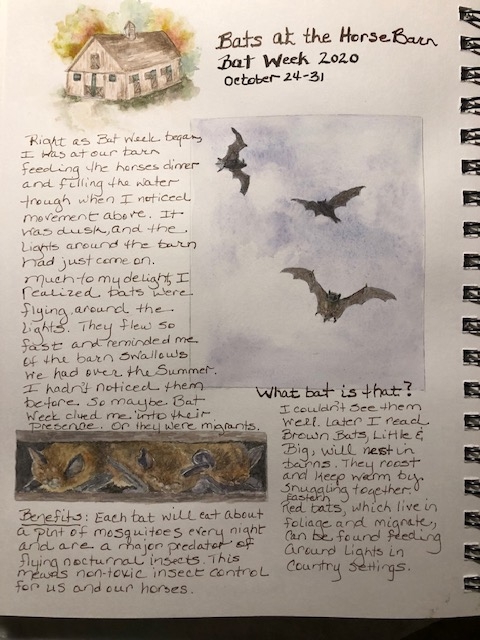Educating about “Bat Week 2020” through Nature Journaling
Article by Elaine Sevy, FMN member
Mention bats and many people cringe. Not me!
Though I didn’t know much about them, I looked forward to seeing them each summer, emerging at dusk to dive and swoop in the sky chasing insects. They’ve always seemed mysterious but never frightening.
As the years passed, I saw fewer and fewer of them each summer in my Springfield, Virginia neighborhood. It was comforting to still see their aerial acrobatics at the barn where I kept my horse, but numbers were dropping there too.
When my Virginia Master Naturalists, Fairfax Chapter (FMN) chapter advertised a World Habitat Council webinar about bats, co-sponsored by the U.S. Department of Agriculture, I registered immediately. “From Tequila to Pest Control: Learn all the Ways Bats are Vital to Ecosystems and Economies”, opened the door to a fascinating new world of all kinds of bats and why we need them. I learned that: “Although we may not always see them, bats are hard at work all around the world each night – they are pollinators, dispersers of seeds and controllers of insect pests”. FMN members were also urged to participate in “Bat Week 2020 (October 24-31)”, an international celebration to raise awareness about the need for bat conservation.

Another Virginia Master Naturalists webinar, “Get Batty,” helped me focus the educational material to Virginia native bats. Dr. Mark Ford, associate professor of wildlife conservation, Virginia Tech College of Natural Resources and Environment, taught us about “… the threats facing some Virginia bat communities due to invasive fungal disease, wind-energy expansion, and urbanization.” We learned how Virginia Tech researchers “…have been working to better define bat distribution, current status, and habitat associations/needs within and around the commonwealth.”
When Dr. Ford said that Little Brown Bat populations had plummeted by 90% due to White Nose Syndrome, and many bat species were endangered, the sadness I felt quickly grew into a sense of urgency. I began brainstorming ways to educate our community about the bats found in Virginia and especially in Fairfax County.
Bat programs offered through Fairfax County parks are very popular and they fill quickly. Our Fairfax County Park Authority naturalists deserve lots of praise for offering these valuable community programs.
Given COVID restrictions and time restraints, I decided to use The NOVA Nature Journal Club (NNJC) on Facebook, a group I administer, as my education platform. The NNJC is inspired by the teachings of Artist, Naturalist John Muir Laws and his philosophy of “Nature Stewardship through Science, Education and Art,” (johnmuirlaws.com). Mr. Laws has been very supportive of our group’s creation and ongoing programs.

Dr. Ford was very helpful and put together a list for me of 16 bats that reside in or migrate through Virginia. “Bats of Fairfax County,” which lists seven common bat species on the county’s website, Virginia’s Department of Wildlife Resources’ “Guide to Bats of Virginia” and Bat Conservation International became my go to sources for creating a brief biography of each species of bat.
A request to use photos from the “The Save Lucy Campaign,” a local nonprofit committed to saving bats, quickly became a collaboration thanks to Leslie Sturges, Save Lucy’s President, who offered to work with our group on the week-long education effort. She taught us so much about our local bats, offered photos, video clips, her personal stories about rehabilitating bats, and shared our journal pages on “Save Lucy’s” website and Facebook page.
With so much encouragement and valuable information, the “Bat Week 2020” virtual education program through nature journaling kicked off on Oct 24 and continued through Oct 31. A different bat was featured each of the eight days with photos, specific information about its conservation status; migratory, roosting and hibernation habits, physical attributes for ID, mating patterns, fun facts and more.
Our group had fun and learned a lot about bats that week. We were even able to feature a “How to Draw a Bat” video lesson by John Muir Laws. We all shared the posts with other Facebook groups and friends. One of our members, Deirdre Pistochini, an award winning artist, took nature journaling to a whole new level. She produced a series of 9 beautifully illustrated journal pages about Virginia’s bats that was featured by The Save Lucy Campaign as an online flip book during Bat Week.
The “Bat Week” journal pages are still featured on the “Save Lucy” website. Go to the Education Link and Scroll down to “Things to do” to view them.
I am so grateful to FMN for sharing excellent programs about bats with our members and everyone’s support in helping me put this educational program together.
Leslie Sturges and I are already considering future collaborations when COVID restrictions are lifted and it’s safe to hold in-person educational programs with live bats.




